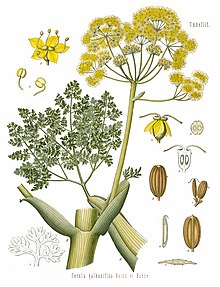Galbanum
Galbanum (also mother resin , galbanum and Galban called) is the dried latex ( gum ), dated as Galbansaft and Galbangummi referred, of Ferula gummosa Boiss. or Ferula galbaniflua Boiss. & Buhse or Ferula erubescens Boiss. , a group of umbel plants , the stick herbs from Persia and the area east of the Aral Sea .
The goods come via the Levantic ports from Syria , Persia, Arabia , partly also from East India and, like many other such drugs, form two types, in tears or grains and in bulk or cakes, the former in lighter, white or yellowish, translucent, wax-shining , pea to nut-sized grains, the latter in darker, brownish or greenish clumps, interspersed with light-colored grains.
The Latin name galbanum originated from the Greek-Semitic word chalbáne (cf. Hebrew chelb or chelb'neh : milk, slime, gum) and is based on the Latin galb (an) us (green-yellow, yellowish).
The substance is quite soft and sticky, only pulverizable in the cold. It contains about 60 percent ethanol- soluble resin, 20 percent gum and up to 6 percent essential oil ( Oleum galbani ) of which it has a pervasive, unpleasant aromatic odor. The taste is bitterly sharp, burning. By distillation with water, the oil is obtained as a colorless liquid that browns and thickens in the air, smells stronger than the resin, tastes bitter and camphor- like.
The galbanum is of little importance for technical purposes; it is sometimes listed as a component of kitten (so-called diamond glue ). Medically, the oil and the cleaned and powdered resin are used internally and the latter externally as an emollient for ulcers and tumors and form the main component of the "mother plaster". In the past, various diseases of women were treated with galbanum, because the resin was considered to promote menstruation. This use brought Galbanum the name "mother resin".
Today the galban resin is extracted exclusively in Iran, around 80 tons per year. The resin extract (resinoid) and the essential oil are commercially available. Today, both are often used in perfumery to give the respective fragrance composition a fresh green note. The essential oil is also used in aromatherapy.
literature
- Lisa Takler: Volatile compounds and antimicrobial effects of selected resins and balms from A – J. Thesis. Univers. Vienna, 2015, pp. 112–117; univie.ac.at (PDF; 3.18 MB) accessed on November 1, 2016.
Web links
- Early New High German dictionary: galban (um).
- Adelung ( Grammatical-Critical Dictionary of High German Dialect ): Gálbanum.
Individual evidence
- ↑ Dieter Lehmann: Two medical prescription books of the 15th century from the Upper Rhine. Part I: Text and Glossary. (= Würzburg medical historical research. 34). Horst Wellm, Pattensen / Han. 1985, ISBN 3-921456-63-0 , p. 176 f.
- ↑ Ludwig August Kraus: Kritisch-Etymologisches medicinisches Lexikon, or explanation of the origin of the Greek, Latin and Oriental. Languages in medicine and in the art expressions initially taken up with it. 3rd, greatly increased and improved edition. Deuerlich & Dieterich, Göttingen 1844, p. 403 f., Archive.org .
- ↑ Helmut Genaust: Etymological dictionary of botanical plant names. Birkhäuser, Basel / Stuttgart 1976, ISBN 3-7643-0755-2 , p. 175.
- ^ O. Weise: On the characteristics of folk etymology. In: Zeitschrift für Völkerpsychologie und Sprachwissenschaft , Volume 12, 1880, pp. 203-223; here: p. 216.
- ↑ Galbanum (ferula galbaniflua). Retrieved December 5, 2015 .

